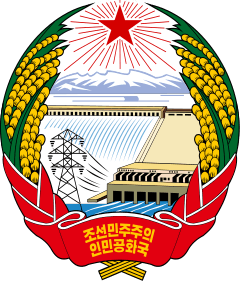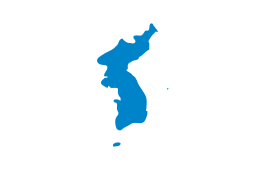Kim Il-sung
Kim Il-sung or Kim Il Sung[lower-alpha 3] (/ˈkɪm ˈɪlˈsʌŋ, -ˈsʊŋ/;[3] Korean: 김일성, Korean pronunciation: [kimils͈ʌŋ]; born Kim Sŏng-ju (김성주), 15 April 1912 – 8 July 1994) was the founder of North Korea, which he ruled from the country's establishment in 1948 until his death in 1994. He held the posts of Premier from 1948 to 1972 and President from 1972 to 1994. He was also the leader of the Workers' Party of Korea (WPK) from 1949 to 1994 (titled as Chairman from 1949 to 1966 and as General Secretary after 1966). Coming to power after the end of Japanese rule in 1945, he authorized the invasion of South Korea in 1950, triggering an intervention in defense of South Korea by the United Nations led by the United States. Following the military stalemate in the Korean War, a ceasefire was signed on 27 July 1953. He was the third longest-serving non-royal head of state/government in the 20th century, in office for more than 45 years.
Kim Il-sung | |
|---|---|
김일성 | |
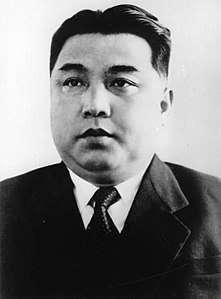 Kim Il-sung in 1950 | |
| 1st Supreme Leader of North Korea | |
| In office 9 September 1948[1] – 8 July 1994 | |
| Preceded by | Position created |
| Succeeded by | Kim Jong-il |
| 1st President of North Korea | |
| In office 28 December 1972 – 8 July 1994 | |
| Premier | Kim Il Pak Song-chol Ri Jong-ok Kang Song-san Ri Kun-mo Yon Hyong-muk Kang Song-san |
| Vice President | |
| Preceded by | Office established[lower-alpha 1] |
| Succeeded by | Office abolished[lower-alpha 2] |
| 1st Premier of North Korea | |
| In office 9 September 1948 – 28 December 1972 | |
| First Vice Premier | Kim Il |
| Vice Premier | Pak Hon-yong Hong Myong-hui Kim Chaek Kim Il Jong Il-ryong Nam Il Pak Ui-wan Jong Jun-thaek Kim Kwang-hyop Kim Chang-man Ri Jong-ok Ri Ju-yon Pak Song-chol Choe Yong-jin |
| Preceded by | Office established |
| Succeeded by | Kim Il |
| General Secretary of the Workers' Party of Korea | |
| In office 30 June 1949 – 8 July 1994 Titled as Chairman until 11 October 1966 | |
| Preceded by | Kim Tu-bong |
| Succeeded by | Kim Jong-il |
| Supreme Commander of the Korean People's Army | |
| In office 5 July 1950 – 24 December 1991 | |
| Preceded by | Choe Yong-gon |
| Succeeded by | Kim Jong-il |
| Personal details | |
| Born | Kim Sŏng-ju 15 April 1912 |
| Died | 8 July 1994 (aged 82) |
| Resting place | Kumsusan Palace of the Sun, Pyongyang |
| Nationality | North Korean |
| Political party | Workers' Party of Korea |
| Other political affiliations | Workers' Party of North Korea (1946–1949) Communist Party of China (1931–1946) |
| Spouse(s) |
|
| Children |
|
| Parents | |
| Relatives | Kim Chol-ju (younger brother) Kim Yong-ju (younger brother) |
| Residence | Pyongyang, North Korea |
| Profession | Politician |
| Signature | |
| Military service | |
| Allegiance | |
| Branch/service | |
| Years of service |
|
| Rank | |
| Commands | All (Supreme Commander) |
| Battles/wars | |
| Korean name | |
| Chosŏn'gŭl | |
| Hancha | |
| Revised Romanization | Kim Il(-)seong |
| McCune–Reischauer | Kim Ilsŏng |
| Birth name | |
| Chosŏn'gŭl | |
| Hancha | |
| Revised Romanization | Kim Seong(-)ju |
| McCune–Reischauer | Kim Sŏngchu |
Central institution membership
Other offices held
Republic of Korea
| |
Under his leadership, North Korea was established as a communist state with a publicly owned and planned economy. It had close political and economic relations with the Soviet Union. By the late 1950s and during the 1960s and 1970s, North Korea enjoyed a higher standard of living than the South, which was suffering from political chaos and economic crises. The situation was reversed in the 1980s, as a newly stable South Korea became an economic powerhouse which was fueled by Japanese and American investment, military aid and internal economic development, while North Korea stagnated and then declined during the same period. Differences emerged between North Korea and the Soviet Union, chief among them was Kim Il-sung's philosophy of Juche, which focused on Korean nationalism, self-reliance and socialism. Despite this, the country received funds, subsidies and aid from the USSR (and the Eastern Bloc) until the dissolution of the USSR in 1991. The resulting loss of economic aid adversely affected the North's economy, causing widespread famine in 1994. During this period, North Korea also remained critical of the United States defense force's presence in the region, which it considered imperialist, having seized the American ship USS Pueblo in 1968, which was part of an infiltration and subversion campaign to reunify the peninsula under North Korea's rule. He outlived Joseph Stalin by four decades and Mao Zedong by almost two and remained in power during the terms of office of six South Korean Presidents, ten US Presidents and the rule of British monarchs George VI and later his daughter Elizabeth II. Known as the Great Leader (Suryong), he established a personality cult which dominates domestic politics in North Korea.
At the 6th WPK Congress in 1980, his oldest son Kim Jong-il was elected to be a Presidium member and chosen to be his successor. Kim Il-sung's birthday is a public holiday in North Korea called the "Day of the Sun". In 1998, Kim Il-sung was declared "eternal President of the Republic".
Early life
Controversy about origins
Controversy surrounds Kim's life before the founding of North Korea, with some labeling him an impostor. Several sources indicate that the name "Kim Il-sung" had previously been used by a prominent early leader of the Korean resistance, Kim Kyung-cheon.[4]:44 The Soviet officer Grigory Mekler, who worked with Kim during the Soviet occupation, said that Kim assumed this name from a former commander who had died.[5] However, historian Andrei Lankov has argued that this is unlikely to be true. Several witnesses knew Kim before and after his time in the Soviet Union, including his superior, Zhou Baozhong, who dismissed the claim of a "second" Kim in his diaries.[6]:55 Historian Bruce Cumings pointed out that Japanese officers from the Kwantung Army have attested to his fame as a resistance figure.[7]:160–161 Historians generally accept the view that, while Kim's exploits were exaggerated by the personality cult which was built around him, he was a significant guerrilla leader.[8][9][10]
Family background
—Kim Il-sung, With the Century[11]:110–111
He was born to Kim Hyŏng-jik and Kang Pan-sŏk, who gave him the name Kim Sŏng-ju; Kim also had two younger brothers, Ch’ŏl-chu (or Kim Chul-ju) and Kim Yŏng-ju.[12]:15
Kim's family is said to have originated from Jeonju, North Jeolla Province. His great-grandfather, Kim Ung-u, settled in Mangyongdae in 1860. Kim is reported to have been born in the small village of Mangyungbong (then called Namni) near Pyongyang on 15 April 1912.[13][12]:12 An early semi-official biography of Kim Il-sung, which published in 1964 in Japan with North Korean support, reported that Kim was born in his mother's home in Chingjong, and grew up in Mangyungbong.[14]:73
According to Kim, his family was not very poor, but was always a step away from poverty. Kim said that he was raised in a Presbyterian family, that his maternal grandfather was a Protestant minister, that his father had gone to a missionary school and was an elder in the Presbyterian Church, and that his parents were very active in the religious community.[15][16] According to the official version, Kim's family participated in anti-Japanese activities and in 1920, they fled to Manchuria. Like most Korean families, they resented the Japanese occupation of the Korean peninsula, which began on 29 August 1910.[12]:12 Another view seems to be that his family settled in Manchuria, as many Koreans had at the time, to escape famine. Nonetheless, Kim's parents, especially Kim's mother Kang Ban Suk, played a role in the anti-Japanese struggle that was sweeping the peninsula.[12]:16 Their exact involvement—whether their cause was missionary, nationalist, or both—is unclear nevertheless.[6]:53 Still, Japanese repression of opposition was brutal, resulting in the arrest and detention of more than 52,000 Korean citizens in 1912 alone.[12]:13 This repression forced many Korean families to flee Korea and settle in Manchuria.
Communist and guerrilla activities
In October 1926, Kim founded the Down-with-Imperialism Union.[17] Kim attended Whasung Military Academy in 1926, but finding the academy's training methods outdated, he quit in 1927. From that time, he attended Yuwen Middle School in China's Jilin province up to 1930,[18] where he rejected the feudal traditions of older-generation Koreans and became interested in communist ideologies; his formal education ended when the police arrested and jailed him for his subversive activities. At seventeen, Kim had become the youngest member of an underground Marxist organization with fewer than twenty members, led by Hŏ So, who belonged to the South Manchurian Communist Youth Association. The police discovered the group three weeks after it formed in 1929, and jailed Kim for several months.[6]:52[19]
In 1931, Kim joined the Communist Party of China—the Communist Party of Korea had been founded in 1925, but had been thrown out of the Comintern in the early 1930s for being too nationalist. He joined various anti-Japanese guerrilla groups in northern China. Feelings against the Japanese ran high in Manchuria, but as of May 1930 the Japanese had not yet occupied Manchuria. On 30 May 1930, a spontaneous violent uprising in eastern Manchuria arose in which peasants attacked some local villages in the name of resisting "Japanese aggression."[20] The authorities easily suppressed this unplanned, reckless and unfocused uprising. Because of the attack, the Japanese began to plan an occupation of Manchuria.[21] In a speech before a meeting of Young Communist League delegates on 20 May 1931 in Yenchi County in Manchuria, Kim warned the delegates against such unplanned uprisings as the 30 May 1930 uprising in eastern Manchuria.[22]
Four months later, on 18 September 1931, the "Mukden Incident" occurred, in which a relatively weak dynamite explosive charge went off near a Japanese railroad in the town of Mukden in Manchuria. Although no damage occurred, the Japanese used the incident as an excuse to send armed forces into Manchuria and to appoint a puppet government.[23] In 1935, Kim became a member of the Northeast Anti-Japanese United Army, a guerrilla group led by the Communist Party of China. Kim was appointed the same year to serve as political commissar for the 3rd detachment of the second division, consisting of around 160 soldiers.[6]:53 Here Kim met the man who would become his mentor as a communist, Wei Zhengmin, Kim's immediate superior officer, who served at the time as chairman of the Political Committee of the Northeast Anti-Japanese United Army. Wei reported directly to Kang Sheng, a high-ranking party member close to Mao Zedong in Yan'an, until Wei's death on 8 March 1941.[24]
In 1935, Kim took the name Kim Il-sung, meaning "Kim become the sun".[25]:30 Kim was appointed commander of the 6th division in 1937, at the age of 24, controlling a few hundred men in a group that came to be known as "Kim Il-sung's division". While commanding this division, he executed a raid on Poch’onbo, on 4 June 1937. Although Kim's division only captured the small Japanese-held town just within the Korean border for a few hours, it was nonetheless considered a military success at this time, when the guerrilla units had experienced difficulty in capturing any enemy territory. This accomplishment would grant Kim some measure of fame among Chinese guerrillas, and North Korean biographies would later exploit it as a great victory for Korea. For their part, the Japanese regarded Kim as one of the most effective and popular Korean guerrilla leaders.[7]:160–161[26] He appeared on Japanese wanted lists as the "Tiger".[27] The Japanese "Maeda Unit" was sent to hunt him in February 1940.[27] Later in 1940, the Japanese kidnapped a woman named Kim Hye-sun, believed to have been Kim Il Sung's first wife. After using her as a hostage to try to convince the Korean guerrillas to surrender, she was killed. Kim was appointed commander of the 2nd operational region for the 1st Army, but by the end of 1940 he was the only 1st Army leader still alive. Pursued by Japanese troops, Kim and what remained of his army escaped by crossing the Amur River into the Soviet Union.[6]:53–54 Kim was sent to a camp at Vyatskoye near Khabarovsk, where the Soviets retrained the Korean communist guerrillas. In August 1942, Kim and his army were assigned to a special unit which belong to the Soviet Red Army. Kim's immediate superior was Zhou Baozhong.[28][29] Kim became a Major in the Soviet Red Army and served in it until the end of World War II in 1945.
Return to Korea
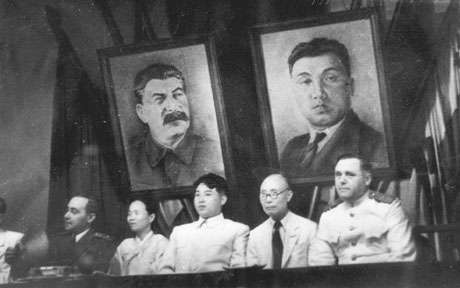
The Soviet Union declared war on Japan on 8 August 1945, and the Red Army entered Pyongyang on 24 August 1945. Stalin had instructed Lavrentiy Beria to recommend a communist leader for the Soviet-occupied territories and Beria met Kim several times before recommending him to Stalin.[13][30][31]
Kim arrived in the Korean port of Wonsan on 19 September 1945 after 26 years in exile.[25]:51 According to Leonid Vassin, an officer with the Soviet MVD, Kim was essentially "created from zero". For one, his Korean was marginal at best; he only had eight years of formal education, all of it in Chinese. He needed considerable coaching to read a speech (which the MVD prepared for him) at a Communist Party congress three days after he arrived.[4]:50
In December 1945, the Soviets installed Kim as chairman of the North Korean branch of the Korean Communist Party.[25]:56 Originally, the Soviets preferred Cho Man-sik to lead a popular front government, but Cho refused to support a UN-backed trusteeship and clashed with Kim.[32] General Terentii Shtykov, who led the Soviet occupation of northern Korea, supported Kim over Pak Hon-yong to lead the Provisional People's Committee for North Korea on 8 February 1946.[33] As chairman of the committee, Kim was "the top Korean administrative leader in the North," though he was still de facto subordinate to General Shtykov until the Chinese intervention in the Korean War.[31][25]:56[33]
To solidify his control, Kim established the Korean People's Army (KPA), aligned with the Communist Party, and he recruited a cadre of guerrillas and former soldiers who had gained combat experience in battles against the Japanese and later against Nationalist Chinese troops.[34] Using Soviet advisers and equipment, Kim constructed a large army skilled in infiltration tactics and guerrilla warfare. Prior to Kim's invasion of the South in 1950, which triggered the Korean War, Stalin equipped the KPA with modern, Soviet-built medium tanks, trucks, artillery, and small arms. Kim also formed an air force, equipped at first with Soviet-built propeller-driven fighters and attack aircraft. Later, North Korean pilot candidates were sent to the Soviet Union and China to train in MiG-15 jet aircraft at secret bases.[35]
Leader of North Korea
Early years
Despite United Nations plans to conduct all-Korean elections, the Soviets held elections of their own in their zone on 25 August 1948 for a Supreme People's Assembly. Voters were presented with a single list from the Communist-dominated Democratic Front for the Reunification of the Fatherland. The Democratic People's Republic of Korea was proclaimed on 9 September 1948, with Kim as the Soviet-designated premier. On 15 August 1948, the south had declared statehood as the Republic of Korea. The Communist Party was nominally led by Kim Tu-bong, though from the outset Kim Il-sung held the real power.
On 12 October, the Soviet Union recognized Kim's government as the sovereign government of the entire peninsula, including the south.[36] The Communist Party merged with the New People's Party of Korea to form the Workers' Party of North Korea, with Kim as vice-chairman. In 1949, the Workers' Party of North Korea merged with its southern counterpart to become the Workers' Party of Korea (WPK) with Kim as party chairman.[37] By 1949, Kim and the communists had consolidated their rule in North Korea.[4]:53 Around this time, Kim began promoting an intense personality cult. The first of many statues of him appeared, and he began calling himself "Great Leader".[4]:53
In February 1946, Kim Il-sung decided to introduce a number of reforms. Over 50% of the arable land was redistributed, an 8-hour work day was proclaimed and all heavy industry was to be nationalized.[38] There were improvements in the health of the population after he nationalized healthcare and made it available to all citizens.[39]
Korean War
Archival material suggests[40][41][42] that North Korea's decision to invade South Korea was Kim's initiative, not a Soviet one. Evidence suggests that Soviet intelligence, through its espionage sources in the US government and British SIS, had obtained information on the limitations of US atomic bomb stockpiles as well as defense program cuts, leading Stalin to conclude that the Truman administration would not intervene in Korea.[43]
China acquiesced only reluctantly to the idea of Korean reunification after being told by Kim that Stalin had approved the action.[40][41][42] The Chinese did not provide North Korea with direct military support (other than logistics channels) until United Nations troops, largely US forces, had nearly reached the Yalu River late in 1950. At the outset of the war in June and July, North Korean forces captured Seoul and occupied most of the South, save for a small section of territory in the southeast region of the South that was called the Pusan Perimeter. But in September, the North Koreans were driven back by the US-led counterattack that started with the UN landing in Incheon, followed by a combined South Korean-US-UN offensive from the Pusan Perimeter. By October, UN forces had retaken Seoul and invaded the North to reunify the country under the South. On 19 October, US and South Korean troops captured P’yŏngyang, forcing Kim and his government to flee north, first to Sinuiju and eventually into Kanggye.[44][45]
On 25 October 1950, after sending various warnings of their intent to intervene if UN forces did not halt their advance,[46]:23 Chinese troops in the thousands crossed the Yalu River and entered the war as allies of the KPA. There were nevertheless tensions between Kim and the Chinese government. Kim had been warned of the likelihood of an amphibious landing at Incheon, which was ignored. There was also a sense that the North Koreans had paid little in war compared to the Chinese who had fought for their country for decades against foes with better technology.[46]:335–336 The UN troops were forced to withdraw and Chinese troops retook P’yŏngyang in December and Seoul in January 1951. In March, UN forces began a new offensive, retaking Seoul and advanced north once again halting at a point just north of the 38th Parallel. After a series of offensives and counter-offensives by both sides, followed by a grueling period of largely static trench warfare that lasted from the summer of 1951 to July 1953, the front was stabilized along what eventually became the permanent "Armistice Line" of 27 July 1953. Over 2.5 million people died during the Korean war.[47]
Chinese and Russian documents from that time reveal that Kim became increasingly desperate to establish a truce, since the likelihood that further fighting would successfully unify Korea under his rule became more remote with the UN and US presence. Kim also resented the Chinese taking over the majority of the fighting in his country, with Chinese forces stationed at the center of the front line, and the Korean People's Army being mostly restricted to the coastal flanks of the front.[48]
Consolidating power
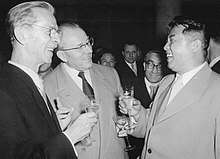
With the end of the Korean War, despite the failure to unify Korea under his rule, Kim il-sung proclaimed the war a victory in the sense that he had remained in power in the north. However, the three-year war left North Korea devastated, and Kim immediately embarked on a large reconstruction effort. He launched a five-year national economic plan to establish a command economy, with all industry owned by the state and all agriculture collectivized. The economy was focused on heavy industry and arms production. By the 1960s, North Korea briefly enjoyed a standard of living higher than the South, which was fraught with political instability and economic crises.[49][50][51] Both South and North Korea retained huge armed forces to defend the 1953 Demilitarized Zone, and US forces remained in the South.
In the ensuing years, Kim established himself as an independent leader of international communism. In 1956, he joined Mao in the "anti-revisionist" camp, which did not accept Nikita Khrushchev's program of de-Stalinization, yet he did not become a Maoist himself. At the same time, he consolidated his power over the Korean communist movement. Rival leaders were eliminated. Pak Hon-yong, leader of the Korean Communist Party, was purged and executed in 1955. Choe Chang-ik appears to have been purged as well.[52][53] The 1955 Juche speech, which stressed Korean independence, debuted in the context of Kim's power struggle against leaders such as Pak, who had Soviet backing. This was little noticed at the time until state media started talking about it in 1963.[54][55]
Kim Il-sung's cult of personality had initially been criticized by some members of the government. The North Korean ambassador to the USSR, Li Sangjo, a member of the Yan'an faction, reported that it had become a criminal offense to so much as write on Kim's picture in a newspaper and that he had been elevated to the status of Marx, Lenin, Mao, and Stalin in the communist pantheon. He also charged Kim with rewriting history so it would appear as if his guerrilla faction had single-handedly liberated Korea from the Japanese, completely ignoring the assistance of the Chinese People's Volunteers. In addition, Li stated that in the process of agricultural collectivization, grain was being forcibly confiscated from the peasants, leading to "at least 300 suicides" and he also stated that Kim made nearly all major policy decisions and appointments himself. Li reported that over 30,000 people were in prison for completely unjust and arbitrary reasons which were as trivial as not printing Kim Il-sung's portrait on sufficient quality paper or using newspapers with his picture to wrap parcels. Grain confiscation and tax collection were also conducted with force, which consisted of violence, beatings, and threats of imprisonment.[56]
During the 1956 August Faction Incident, Kim Il-sung successfully resisted Soviet and Chinese efforts to depose him in favor of pro-Soviet Koreans or Koreans who belonged to the pro-Chinese Yan'an faction.[57][58] The last Chinese troops withdrew from the country in October 1958, which is the consensus as the latest date when North Korea became effectively independent, though some scholars believe that the 1956 August incident demonstrated North Korea's independence.[57][58]
During his rise and consolidation of power, Kim created the songbun caste system, which divided the North Korean people into three groups. Each person was classified as belonging to the “core,” “wavering,” or “hostile” class, based on his or her political, social, and economic background – a system which persists today. Songbun was used to decide all aspects of a person's existence in North Korean society, including access to education, housing, employment, food rationing, ability to join the ruling party, and even where a person was allowed to live. Large numbers of people from the so-called hostile class, which included intellectuals, land owners, and former supporters of Japan's occupying government during World War II, were forcibly relocated to the country's isolated and impoverished northern provinces. When years of famine ravaged the country in the 1990s, those people who lived in its marginalized and remote communities were hardest hit.[59]
During his rule, North Korea was responsible for widespread human rights abuses.[60][61][62] Kim Il-Sung punished real and perceived dissent through purges which included public executions and enforced disappearances. Not only dissenters but their entire extended families were reduced to the lowest songbun rank, and many of them were relocated to a secret system of political prison camps. These camps or kwanliso, a part of Kim's vast network of abusive penal and forced labor institutions, were fenced and heavily guarded colonies in mountainous areas of the country, where prisoners were forced to perform back-breaking labor such as logging, mining, and picking crops. Most prisoners were held in these camps for life, and their living and working conditions in them were often deadly. For example, prisoners were nearly starved to death, denied medical care, denied proper housing and clothes, subjected to sexual violence, regularly mistreated, tortured and executed by guards.[59]
Later rule
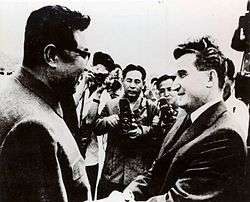
Despite his opposition to de-Stalinization, Kim never officially severed relations with the Soviet Union, and he did not take part in the Sino-Soviet Split. After Khrushchev was replaced by Leonid Brezhnev in 1964, Kim's relations with the Soviet Union became closer. At the same time, Kim was increasingly alienated by Mao's unstable style of leadership, especially during the Cultural Revolution in the late 1960s. Kim in turn was denounced by Mao's Red Guards.[63] At the same time, Kim reinstated relations with most of Eastern Europe's communist countries, primarily with Erich Honecker's East Germany and Nicolae Ceauşescu's Romania. Ceauşescu, in particular, was heavily influenced by Kim's ideology, and the personality cult which grew around him in Romania was very similar to that of Kim.[64]
However, Albania's Enver Hoxha (another independent-minded communist leader) was a fierce enemy of the country and Kim Il-sung, writing in June 1977 that "genuine Marxist-Leninists" will understand that the "ideology which is guiding the Korean Workers' Party and the Communist Party of China...is revisionist" and later that month he added that "in Pyongyang, I believe that even Tito will be astonished at the proportions of the cult of his host [Kim Il Sung], which has reached a level unheard of anywhere else, either in past or present times, let alone in a country which calls itself socialist."[65][66] He further claimed that "the leadership of the Communist Party of China has betrayed [the working people]. In Korea, too, we can say that the leadership of the Korean Workers' Party is wallowing in the same waters" and claimed that Kim Il Sung was begging for aid from other countries, especially among the Eastern Bloc and non-aligned countries like Yugoslavia. As a result, relations between North Korea and Albania would remain cold and tense right up until Hoxha's death in 1985. Although a resolute anti-communist, Zaire's Mobutu Sese Seko was also heavily influenced by Kim's style of rule.[67] At the same time, Kim was establishing an extensive personality cult. Kim developed the policy and ideology of Juche in opposition to the idea of North Korea as a satellite state of China or the Soviet Union.
In the 1960s, Kim became impressed with the efforts of North Vietnamese Leader Ho Chi Minh to reunify Vietnam through guerrilla warfare and thought that something similar might be possible in Korea.[68]:30–31 Infiltration and subversion efforts were thus greatly stepped up against US forces and the leadership in South Korea.[68]:32–33 These efforts culminated in an attempt to storm the Blue House and assassinate President Park Chung-hee.[68]:32 North Korean troops thus took a much more aggressive stance toward US forces in and around South Korea, engaging US Army troops in fire-fights along the Demilitarized Zone. The 1968 capture of the crew of the spy ship USS Pueblo was a part of this campaign.[68]:33
The North Korean government's practice of abducting foreign nationals, such as South Koreans, Japanese, Chinese, Thais, and Romanians, is another practice of Kim Il-Sung which persists to the present day. Kim Il-Sung planned these operations to seize persons who could be used to support North Korea's overseas intelligence operations, or those who had technical skills to maintain the socialist state's economic infrastructure in farms, construction, hospitals, and heavy industry. According to the Korean War Abductees Family Union (KWAFU), those abducted by North Korea after the war included 2,919 civil servants, 1,613 police, 190 judicial officers and lawyers, and 424 medical practitioners. In the hijacking and seizure of Korean Airlines flight YS-11 in 1969 by North Korean agents, the pilots and mechanics, and others with specialized skills, were the only ones never permitted to return to South Korea. The total number of foreign abductees and disappeared is still unknown, but is estimated to include more than 200,000 people. The vast majority of disappearances occurred or were linked to the Korean War, but hundreds of South Koreans and Japanese people were abducted during the 1960s and 1980s. A number of South Koreans and nationals of the People's Republic of China have also been apparently abducted in the 2000s and 2010s. At least 100,000 people remain disappeared.[59]
A new constitution was proclaimed in December 1972, which created an executive presidency. Kim gave up the premiership and was elected president. On 14 April 1975, North Korea discontinued most formal use of its traditional units and adopted the metric system.[69] In 1980, he decided that his son Kim Jong-il would succeed him, and increasingly delegated the running of the government to him. The Kim family was supported by the army, due to Kim Il-sung's revolutionary record and the support of the veteran defense minister, O Chin-u. At the Sixth Party Congress in October 1980, Kim publicly designated his son as his successor. In 1986, a rumor spread that Kim had been assassinated, making the concern for Jong-il's ability to succeed his father actual. Kim dispelled the rumors, however, by making a series of public appearances. It has been argued, however, that the incident helped establish the order of succession—the first patrifilial in a communist state—which eventually would occur upon Kim Il-Sung's death in 1994.[70]
From about this time, North Korea encountered increasing economic difficulties. South Korea became an economic powerhouse fueled by Japanese and American investment, military aid, and internal economic development, while North Korea stagnated and then declined in the 1980s.[71][72] The practical effect of Juche was to cut the country off from virtually all foreign trade in order to make it entirely self-reliant. The economic reforms of Deng Xiaoping in China from 1979 onward meant that trade with the moribund economy of North Korea held decreasing interest for China. The Revolutions of 1989 in Eastern Europe and the Soviet Union, from 1989–1992, completed North Korea's virtual isolation. These events led to mounting economic difficulties because Kim refused to issue any economic or political reforms.[73]
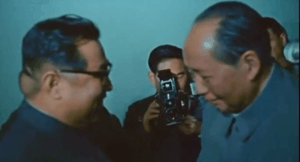
As he aged, starting in the 1970s, Kim developed a calcium deposit growth on the right side of the back of his neck. It was long believed that its close proximity to his brain and spinal cord made it inoperable. However, Juan Reynaldo Sanchez, a defected bodyguard for Fidel Castro who met Kim in 1986 wrote later that it was Kim's own paranoia that prevented it from being operated on. [74] Because of its unappealing nature, North Korean reporters and photographers were required to photograph Kim while standing slightly to his left in order to hide the growth from official photographs and newsreels. Hiding the growth became increasingly difficult as the growth reached the size of a baseball by the late 1980s.[75]:xii
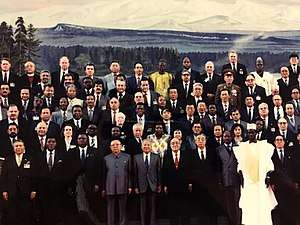
To ensure a full succession of leadership to his son and designated successor Kim Jong-il, Kim turned over his chairmanship of North Korea's National Defense Commission—the body mainly responsible for control of the armed forces as well as the supreme commandership of the country's now million-man strong military force, the Korean People's Army—to his son in 1991 and 1993. So far, the elder Kim—even though he is dead—has remained the country's president, the general-secretary of its ruling Workers' Party of Korea, and the chairman of the Party's Central Military Commission, the party's organization that has supreme supervision and authority over military matters.
In early 1994, Kim began investing in nuclear power to offset energy shortages brought on by economic problems. This was the first of many "nuclear crises". On 19 May 1994, Kim ordered spent fuel to be unloaded from the already disputed nuclear research facility in Yongbyon. Despite repeated chiding from Western nations, Kim continued to conduct nuclear research and carry on with the uranium enrichment program. In June 1994, former US president Jimmy Carter travelled to Pyongyang in an effort to persuade Kim to negotiate with the Clinton Administration over its nuclear program.[76] To the astonishment of the United States and the International Atomic Energy Agency, Kim agreed to halt his nuclear research program and seemed to be embarking upon a new opening to the West.[77]
Death
On the late morning of 8 July 1994, Kim Il-sung collapsed from a sudden heart attack at his residence in Hyangsan, North Pyongyan. After the heart attack, Kim Jong-il ordered the team of doctors who were constantly at his father's side to leave, and arranged for the country's best doctors to be flown in from Pyongyang. After several hours, the doctors from Pyongyang arrived, but despite their efforts to save him, Kim Il-sung died later that day at the age of 82. After the traditional Confucian Mourning period, his death was declared thirty hours later.[78]
Kim Il-sung's death resulted in nationwide mourning and a ten-day mourning period was declared by Kim Jong-il. His funeral was on July 17, 1994 in Pyongyang and was attended by hundreds of thousands of people who were flown into the city from all over North Korea. Kim Il-sung's body was placed in a public mausoleum at the Kumsusan Palace of the Sun, where his preserved and embalmed body lies under a glass coffin for viewing purposes. His head rests on a traditional Korean pillow and he is covered by the flag of the Workers' Party of Korea. Newsreel video of the funeral at Pyongyang was broadcast on several networks, and can now be found on various websites.[79]
Personal life
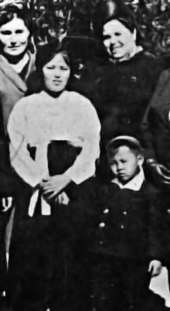
Kim Il-sung married twice. His first wife, Kim Jong Suk (1917–1949), gave birth to two sons before her death in childbirth during the delivery of a stillborn girl. Kim Jong-il was his oldest son. The other son (Kim Man-il, or Shaura Kim) of this marriage died in 1947 in a swimming accident. Kim married Kim Song-ae in 1952, and it is believed that he had three children with her: Kim Yŏng-il (not to be confused with the former Premier of North Korea with the same name), Kim Kyŏng-il, and Kim Pyong-il. Kim Pyong-il was prominent in Korean politics until he became ambassador to Hungary. In 2015, Kim Pyong-il became ambassador to the Czech Republic, but officially retired in 2019 and resides once again in North Korea. Kim was reported to have had other children with women who he was not married to.[80] They included Kim Hyŏn-nam (born 1972, head of the Propaganda and Agitation Department of the Workers' Party since 2002).[81]
Awards
According to North Korean sources, Kim Il-sung had received 230 foreign orders, medals and titles from 70 countries since the 1940s until, and after, his death.[82] They include: The Soviet Order of the Red Banner and the Order of Lenin (twice),[83][84] Order of the Republic of Indonesia (first class), the Bulgarian Order of Georgi Dimitrov (twice), the Togolese Order of Mono (Grand Cross), the Order of the Yugoslav Star (Great Star),[85] the Cuban Order of José Martí (twice), the East German Order of Karl Marx (twice), Order of the Republic of Malta, the Burkinabe Order of the Gold Star of Nahouri, Order of the Grand Star of Honour of Socialist Ethiopia, the Nicaraguan Augusto Cesar Sandino Order, the Vietnamese Gold Star Order,[84] the Czechoslovak Order of Klement Gottwald,[86] the Royal Order of Cambodia (Grand Cross),[87] the Malagasy Grand National Cross (first class),[88] the Mongolian Order of Sukhbaatar,[89] and the Romanian orders of Order of Victory of Socialism and Order of the Star of the Romanian Socialist Republic (first class with band).[84][90]
Legacy
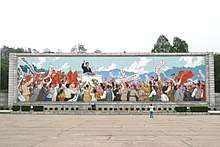
There are over 500 statues of Kim Il-sung in North Korea, similar to the many statues and monuments that Eastern Bloc leaders put up in honor of themselves.[91] The most prominent are at Kim Il-sung University, Kim Il-sung Stadium, Mansudae Hill, Kim Il-sung Bridge and the Immortal Statue of Kim Il-sung. Some statues have reportedly been destroyed by explosions or damaged with graffiti by North Korean dissidents.[4]:201[92] Yŏng Saeng ("eternal life") monuments have been erected throughout the country, each dedicated to the departed "Eternal Leader".[93]
Kim Il-sung's image, especially his posthumous portrait released in 1994, is prominent in places associated with public transportation, which hangs at every North Korean train station and airport.[91] It is also placed prominently at the border crossings between China and North Korea. Thousands of gifts to Kim Il-sung from foreign leaders are housed in the International Friendship Exhibition.[94]
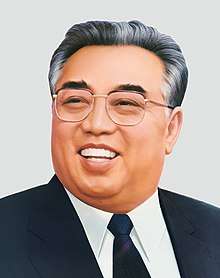
Kim Il-sung's birthday, "Day of the Sun", is celebrated every year as a public holiday in North Korea.[95] The associated April Spring Friendship Art Festival gathers hundreds of artists from all over the world.[96]
Works
Kim Il-sung was the author of many works. According to North Korean sources, these amount to approximately 10,800 speeches, reports, books, treatises, and others.[97] Some, such as the 100-volume Complete Collection of Kim Il-sung's Works (김일성전집), are published by the Workers' Party of Korea Publishing House.[98] Shortly before his death, he published an eight-volume autobiography, With the Century.[32]:26
According to official North Korean sources, Kim Il-sung was the original writer of many plays and operas.[99] One of these, The Flower Girl, a revolutionary theatrical opera, was adapted into a locally produced feature film in 1972.[100][101][11]:178
See also
Notes
- Choi Yong-kun was previously head of state as the President of the Presidium of the Supreme People's Assembly.
- Kim Yong-nam became later head of state as the President of the Presidium of the Supreme People's Assembly.
- Officially transcribed as Kim Il Sung by North Korean sources.
References
- "Kim ll-sung". www.onthisday.com/people/kim-il-sung. Retrieved 28 April 2020.
- "NK founder's second wife died in 2014: Unification Ministry". www.koreaherald.com. 27 December 2018.
- "Kim Il Sung". American Heritage Dictionary of the English Language (Fifth ed.). n.d. Retrieved 6 March 2017.
- Jasper Becker (1 May 2005). Rogue Regime : Kim Jong Il and the Looming Threat of North Korea. Oxford University Press. p. 44. ISBN 978-0-19-803810-8.
- "Soviets groomed Kim Il Sung for leadership". Vladivostok News. 10 January 2003. Archived from the original on 10 June 2009.
- Lankov, Andrei (2002). From Stalin to Kim Il Sung: The Formation of North Korea 1945–1960. Rutgers University Press. ISBN 978-0813531175.
- Cumings, Bruce (17 September 2005). Korea's Place in the Sun: A Modern History (Updated). New York: W W Norton & Co. ISBN 978-0-393-32702-1. Archived from the original on 18 May 2016.
- Buzo, Adrian (2002). The Making of Modern Korea. London: Routledge. p. 56. ISBN 978-0-415-23749-9.
- Robinson, Michael E (2007). Korea's Twentieth-Century Odyssey. Honolulu: University of Hawaii Press. p. 87. ISBN 978-0-8248-3174-5.
- Oberdorfer, Don; Carlin, Robert (2014). The Two Koreas: A Contemporary History. Basic Books. pp. 13–14. ISBN 9780465031238.
- Kim Il-sung (1994). With the Century (PDF). 2. Pyongyang: Foreign Languages Publishing House. OCLC 28377167. Retrieved 17 October 2014.
- Baik Bong (1973). Kim il Sung: Volume I: From Birth to Triumphant Return to Homeland. Beirut, Lebanon: Dar Al-talia.
- "Soviet Officer Reveals Secrets of Mangyongdae". Daily NK. 2 January 2014. Archived from the original on 11 February 2014. Retrieved 15 April 2014.
- Andrei Lankov (2004). The DPRK yesterday and today. Informal history of North Korea. Moscow: Восток-Запад (English: East-West). p. 73. 243895.
- Kimjongilia – The Movie – Learn More Archived 18 September 2010 at the Wayback Machine
- Byrnes, Sholto (7 May 2010). "The Rage Against God, By Peter Hitchens". The Independent. London. Archived from the original on 12 May 2010.
- Smith, Lydia (8 July 2014). "Kim Il-sung Death Anniversary: How the North Korea Founder Created a Cult of Personality". International Business Times UK. Archived from the original on 6 October 2014. Retrieved 1 October 2014.
- Sang-Hun, Choe; Lafraniere, Sharon (27 August 2010). "Carter Wins Release of American in North Korea". The New York Times. Archived from the original on 30 June 2017.
- Suh Dae-Sook, Kim Il Sung: The North Korean Leader, Columbia University Press (1998) p. 7.
- Kim Il-Sung, "Let Us Repudiate the 'Left' Adventurist Line and Follow the Revolutionary Organizational Line" contained in On Juche in Our Revolution (Foreign Languages Publishers: Pyongyang, Korea, 1973)3.
- Yamamuro, Shin'ichi (2006). Manchuria Under Japanese Dominion. ISBN 9780812239126. Archived from the original on 18 May 2016. Retrieved 8 February 2016.
- Kim Il-Sung, "Let Us Repudiate the 'Left' Adventurist Line and Follow the Revolutionary Organizational Line" contained in On Juche in Our Revolution, pp.1-15.
- Kim Il-Sung, "On Waging Armed Struggle Against Japanese Imperialism" on 16 December 1931 contained in On Juche in Our Revolution, pp. 17-20.
- Suh Dae-Sook, Kim Il Sung: The North Korean Leader, Columbia University Press (1998) pp. 8–10.
- Bradley K. Martin (2004). Under the Loving Care of the Fatherly Leader: North Korea and the Kim Dynasty. Thomas Dunne Books. ISBN 978-0-312-32322-6.
- Robinson, Michael E (2007). Korea's Twentieth-Century Odyssey. Honolulu: University of Hawaii Press. pp. 87, 155. ISBN 978-0-8248-3174-5.
- Lone, Stewart; McCormack, Gavan (1993). Korea since 1850. Melbourne: Longman Cheshire. p. 100.
- 寸麗香 (23 December 2011). 金日成父子與周保中父女的兩代友誼. people.com.cn (in Chinese). Retrieved 1 June 2019.
- Fyodor Tertitskiy (4 February 2019). "How an obscure Red Army unit became the cradle of the North Korean elite". NK News. Retrieved 1 June 2019.
- "Wisdom of Korea". ysfine.com. Archived from the original on 28 May 2013.
- Mark O'Neill. "Kim Il-sung's secret history | South China Morning Post". Scmp.com. Archived from the original on 27 February 2014. Retrieved 15 April 2014.
- Armstrong, Charles (15 April 2013). The North Korean Revolution, 1945–1950. Cornell University Press.
- Lankov, Andrei (25 January 2012). "Terenti Shtykov: the other ruler of nascent N. Korea". The Korea Times. Archived from the original on 17 April 2015. Retrieved 14 April 2015.
- "Defense". Archived from the original on 6 March 2016.
- Blair, Clay, The Forgotten War: America in Korea, Naval Institute Press (2003).
- "DPRK Diplomatic Relations". NCNK. 11 April 2017. Archived from the original on 19 April 2014.
- "KBS WORLD Radio". world.kbs.co.kr. Archived from the original on 5 March 2008.
- Kim Il Sung: The North Korean Leader page 68
- Behnke, Alison (1 August 2012). Kim Jong Il's North Korea. ISBN 9781467703550.
- Weathersby, Kathryn, "The Soviet Role in the Early Phase of the Korean War", The Journal of American-East Asian Relations 2, no. 4 (Winter 1993): 432
- Goncharov, Sergei N., Lewis, John W. and Xue Litai, Uncertain Partners: Stalin, Mao, and the Korean War (1993)
- Mansourov, Aleksandr Y., Stalin, Mao, Kim, and China's Decision to Enter the Korean War, 16 September – 15 October 1950: New Evidence from the Russian Archives, Cold War International History Project Bulletin, Issues 6–7 (Winter 1995/1996): 94–107
- Sudoplatov, Pavel Anatoli, Schecter, Jerrold L., and Schecter, Leona P., Special Tasks: The Memoirs of an Unwanted Witness—A Soviet Spymaster, Little Brown, Boston (1994)
- Mossman, Billy (29 June 2005). United States Army in the Korean War: Ebb and Flow November 1950-July 1951. University Press of the Pacific. p. 51.
- Sandler, Stanley (1999). The Korean War: No Victors, No Vanquished. The University Press of Kentucky. p. 108.
- David Halberstam. Halberstam, David (25 September 2007). The Coldest Winter: America and the Korean War. Hyperion. Kindle Edition.
- Bethany Lacina and Nils Petter Gleditsch, Monitoring Trends in Global Combat: A New Dataset of Battle Deaths Archived 12 October 2013 at the Wayback Machine, European Journal of Population (2005) 21: 145–166.
- "25 October 1950". teachingamericanhistory.org.
- Buzo, Adrian (2002). The Making of Modern Korea. London: Routledge. p. 140. ISBN 978-0-415-23749-9.
- Cumings, Bruce (2005). Korea's Place in the Sun: A Modern History. New York: W. W. Norton & Company. p. 434. ISBN 978-0-393-32702-1.
- Robinson, Michael E (2007). Korea's Twentieth-Century Odyssey. Honolulu: University of Hawaii Press. p. 153. ISBN 978-0-8248-3174-5.
- Lankov, Andrei N., Crisis in North Korea: The Failure of De-Stalinization, 1956, Honolulu: Hawaii University Press (2004), ISBN 978-0-8248-2809-7
- Timothy Hildebrandt, "Uneasy Allies: Fifty Years of China-North Korea Relations" Archived 24 February 2015 at the Wayback Machine, Asia Program Special Report, September 2003, Woodrow Wilson International Centre for Scholars.
- Chung, Chin O. Pyongyang Between Peking and Moscow: North Korea's Involvement in the Sino-Soviet Dispute, 1958-1975. University of Alabama. 1978.
- French, Paul. North Korea: State of Paranoia. New York: St. Martin's Press. 2014.
- Ri, Sang-jo. "Letter from Ri Sang-jo to the Central Committee of the Korean Workers Party". Woodrow Wilson Center. Retrieved 5 March 2014.
- Chung, Chin O. Pyongyang Between Peking and Moscow: North Korea's Involvement in the Sino-Soviet Dispute, 1958-1975. University of Alabama, 1978, p. 45.
- Kim Young Kun; Zagoria, Donald S. (December 1975). "North Korea and the Major Powers". Asian Survey. 15 (12): 1017–1035. doi:10.2307/2643582. JSTOR 2643582.
- North Korea: Kim Il-Sung's Catastrophic Rights Legacy 13 April 2016. Human Rights Watch, 2016.
- Black Book of Communism, pg. 564.
- The Worst of the Worst: The World's Most Repressive Societies Archived 7 June 2013 at the Wayback Machine. Freedom House, 2012.
- Statistics of democide - Chapter 10 - Statistics Of North Korean Democide - Estimates, Calculations, And Sources by Rudolph Rummel.
- "Breznhev-Kim Il-Sung relations".
- Behr, Edward Kiss the Hand You Cannot Bite, New York: Villard Books, 1991 page 195.
- Enver Hoxha, "Reflections on China II: Extracts from the Political Diary", Institute of Marxist–Leninist Studies at the Central Committee of the Party of Labour of Albania," Tirana, 1979, pp 516, 517, 521, 547, 548, 549.
- Radio Free Europe/Radio Liberty Research 17 December 1979 quoting Hoxha's Reflections on China Volume II: "In Pyongyang, I believe that even Tito will be astonished at the proportions of the cult of his host, which has reached a level unheard of anywhere else, either in past or present times, let alone in a country which calls itself socialist." "Albanian Leader's 'Reflections on China,' Volume II". CEU.hu. Archived from the original on 8 September 2009. Retrieved 30 October 2008.
- Howard W. French, With Rebel Gains and Mobutu in France, Nation Is in Effect Without a Government Archived 30 June 2017 at the Wayback Machine, The New York Times (17 March 1997).
- Lankov, Andrei (2015). The Real North Korea: Life and Politics in the Failed Stalinist Utopia. Oxford: Oxford University Press. ISBN 978-0-19-939003-8.
- "DPR Korea", Official site, Asia–Pacific Legal Metrology Forum, 2015, archived from the original on 9 February 2017.
- Haberman, Clyde; Times, Special to The New York (17 November 1986). "Kim Il Sung, at 74, Is Reported Dead". The New York Times. Archived from the original on 19 March 2017. Retrieved 19 March 2017.
- Bluth, Christoph (2008). Korea. Cambridge: Polity Press. p. 34. ISBN 978-07456-3357-2.
- North Korea - From 1970 to the death of Kim Il-Sung on Encyclopædia Britannica.
- "North Korea and Eastern Europe". Archived from the original on 10 March 2016.
- Juan Reinaldo Sanchez, The Double Life of Fidel Castro: My 17 Years as Personal Bodyguard to El Lider Maximo, Penguin Press (2014) p. 234.
- Cumings, Bruce (2003). North Korea: Another Country. New York: New Press. p. 115. ISBN 978-1-56584-940-2.CS1 maint: ref=harv (link)
- Blakemore, Erin (1 September 2018). "Bill Clinton Once Struck a Nuclear Deal With North Korea". history.com. A&E Television Networks. Retrieved 3 July 2019.
- "Chronology of U.S.-North Korean Nuclear and Missile Diplomacy | Arms Control Association". www.armscontrol.org. Archived from the original on 22 April 2012.
- Demick, Barbara: Nothing to Envy: Ordinary Lives in North Korea.
- Scenes of lamentation after Kim Il-sung’s death on YouTube
- Saxonberg, Steven (14 February 2013). Transitions and Non-Transitions from Communism: Regime Survival in China, Cuba, North Korea, and Vietnam. Cambridge University Press. p. 123. ISBN 978-1-107-02388-8. Archived from the original on 18 May 2016.
- Henry, Terrence (1 May 2005). "After Kim Jong Il". The Atlantic. Retrieved 1 October 2014.
- Jo Am; An Chol-gang, eds. (2002). "The Foreign Orders and Honorary Titles Awarded to President Kim Il Sung". Korea in the 20th Century: 100 Significant Events. Translated by Kim Yong-nam; Kim Kyong-il; Kim Jong-shm. Pyongyang: Foreign Languages Publishing House. p. 162. OCLC 276996886.
- Westad, Odd Arne (2017). The Cold War: A World History. New York: Basic Books. p. 190. ISBN 978-0-465-09313-7.
- "Kim Il Sung". Who's Who in Asian and Australasian Politics. London: Bowker-Saur. 1991. p. 146. ISBN 978-0-86291-593-3.
- Acović, Dragomir (2012). Slava i čast: Odlikovanja među Srbima, Srbi među odlikovanjima. Belgrade: Službeni Glasnik. p. 605.CS1 maint: ref=harv (link)
- "Řád Klementa Gottwalda: za budování socialistické vlasti" (PDF) (in Czech). Archiv Kanceláře Prezidenta Republiky. 17 January 2015. p. 11. Archived from the original (PDF) on 22 August 2016. Retrieved 21 June 2018.
- News from Hsinhua News Agency: Daily Bulletin. London: Xin hua tong xun she. 1 October 1965. p. 53. OCLC 300956682.
- Summary of World Broadcasts: Far East, Part 3. Reading: Monitoring Service of the British Broadcasting Corporation. 1985. OCLC 976978783.
- Sanders, Alan J. K. (2010). "Orders and medals". Historical Dictionary of Mongolia (Third ed.). Lanham: Scarecrow Press. p. 551. ISBN 978-0-8108-7452-7.
- "Gifts of World People". Korea Today. No. 304–315. Pyongyang: Foreign Languages Publishing House. 1982. p. 58. ISSN 0454-4072.
- Portal, Jane; British Museum (2005). Art under control in North Korea. Reaktion Books. p. 82. ISBN 978-1-86189-236-2.
- "The Chosun Ilbo (English Edition): Daily News from Korea - N.Korean Dynasty's Authority Challenged". English.chosun.com. 13 February 2012. Archived from the original on 29 September 2012. Retrieved 9 November 2012.
- "Controversy Stirs Over Kim Monument at PUST" NK Daily. Archived 12 April 2010 at the Wayback Machine. Retrieved 24 April 2010.
- "North Korean museum shows off leaders' gifts". The Age. Reuters. 21 December 2006.
- Birthday of Kim Il-sung. Holidays, Festivals, and Celebrations of the World Dictionary (Fourth ed.). Omnigraphics. 2010. Retrieved 3 May 2015 – via TheFreeDictionary.com.
- Choi Song Min (16 April 2013). "Spring Art Festival Off the Schedule". DailyNK. Archived from the original on 13 March 2015. Retrieved 3 May 2015.
- "Immortal classical works written by President Kim Il Sung". Naenara. May 2008. Retrieved 16 January 2015.
- ""Complete Collection of Kim Il Sung's Works" Off Press". KCNA. 18 January 2012. Archived from the original on 12 October 2014. Retrieved 16 January 2015.
- Suk-Yong Kim (2018). "Dead Father's Living Body: Kim Il-sung's Seed Theory and North Korean Arts". In Kaminskij, Konstantin; Koschorke, Albrecht (eds.). Tyrants Writing Poetry. Budapest: Central European University Press. p. 159. ISBN 978-963-386-202-5.
- "Archived copy" 가극 작품. NK Chosun (in Korean). Archived from the original on 1 December 2005. Retrieved 24 June 2010.CS1 maint: archived copy as title (link)
- "Archived copy" 金日成原创《卖花姑娘》5月上海唱响《卖花歌》. Sohu Entertainment (in Chinese). 26 March 2008. Archived from the original on 1 May 2011. Retrieved 24 June 2010.CS1 maint: archived copy as title (link)
Further reading
- Baik Bong, "From Birth to Triumphant Return to Homeland," "From Building Democratic Korea to Chollima Flight," and "From Independent National Economy to 10-Point Political Programme".
- Blair, Clay, The Forgotten War: America in Korea, Naval Institute Press (2003).
- Kracht, Christian, The Ministry Of Truth: Kim Jong Il's North Korea, Feral House, October 2007, 132 pages, 88 color photographs, ISBN 978-1-932595-27-7.
- Lee Chong-sik. "Kim Il-Song of North Korea." Asian Survey. University of California Press. Vol. 7, No. 6, June 1967. DOI 10.2307/2642612. Available at Jstor.
- NKIDP: Crisis and Confrontation on the Korean Peninsula: 1968–1969, A Critical Oral History
- Sudoplatov, Pavel Anatoli, Schecter, Jerrold L., and Schecter, Leona P., Special Tasks: The Memoirs of an Unwanted Witness—A Soviet Spymaster, Little Brown, Boston (1994).
- Szalontai, Balázs, Kim Il Sung in the Khrushchev Era: Soviet-DPRK Relations and the Roots of North Korean Despotism, 1953-1964. Stanford: Stanford University Press; Washington, D.C.: Woodrow Wilson Center Press (2005).
External links
| Wikiquote has quotations related to: Kim Il-sung |
| Wikimedia Commons has media related to Kim Il-sung. |
- Kim Il-Sung at the Encyclopædia Britannica
- Nicolae Ceausescu's visit to Pyongyang, North Korea, in 1971
- "Conversations with Kim Il Sung" at the Wilson Center Digital Archive
- Kim Il-sung at Curlie
| Government offices | ||
|---|---|---|
| New title | Premier of North Korea 1948–1972 |
Succeeded by Kim Il |
| Preceded by Choe Yong-gon as President of the Presidium of the Supreme People's Assembly |
President of North Korea (Eternal President since 5 September 1998) 1972–1994 |
Succeeded by Yang Hyong-sop as Chairman of the Standing Committee of the Supreme People's Assembly |
| New title | Chairman of the National Defence Commission 1972–1993 |
Succeeded by Kim Jong-il |
| Party political offices | ||
| New title | Chairman of the Workers’ Party of Korea 1949–1966 |
Himself as General Secretary |
| Chairman of the WPK Organization Bureau 1949–1951 |
Succeeded by Pak Yong-bin | |
| Chairman of the WPK Central Military Commission 1950–1994 |
Vacant Title next held by Kim Jong-il | |
| General Secretary of the Workers' Party of Korea 1966–1994 | ||
| Military offices | ||
| Preceded by Choe Yong-gon |
Supreme Commander of the Korean People's Army 1950–1991 |
Succeeded by Kim Jong-il |

